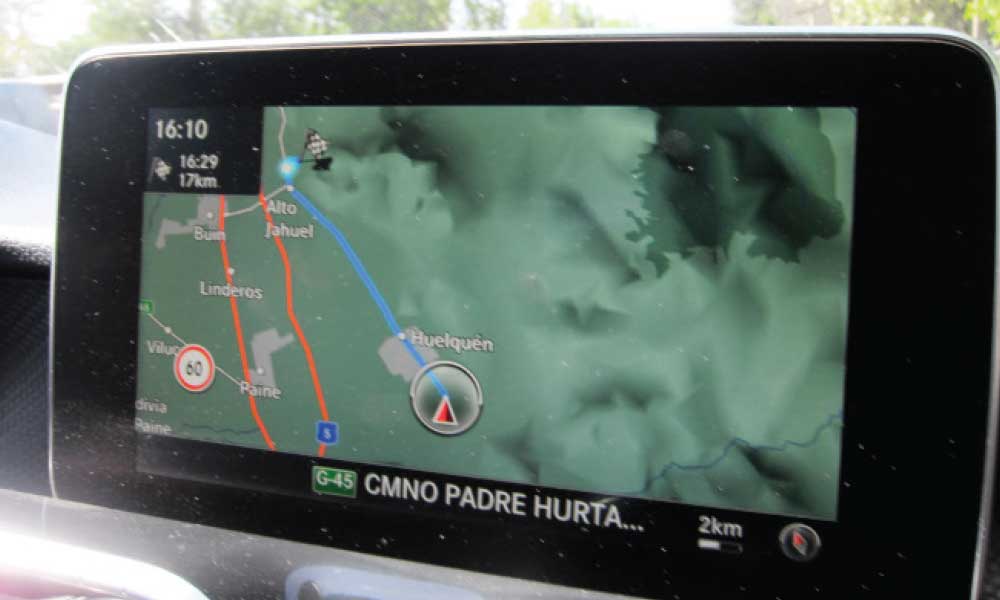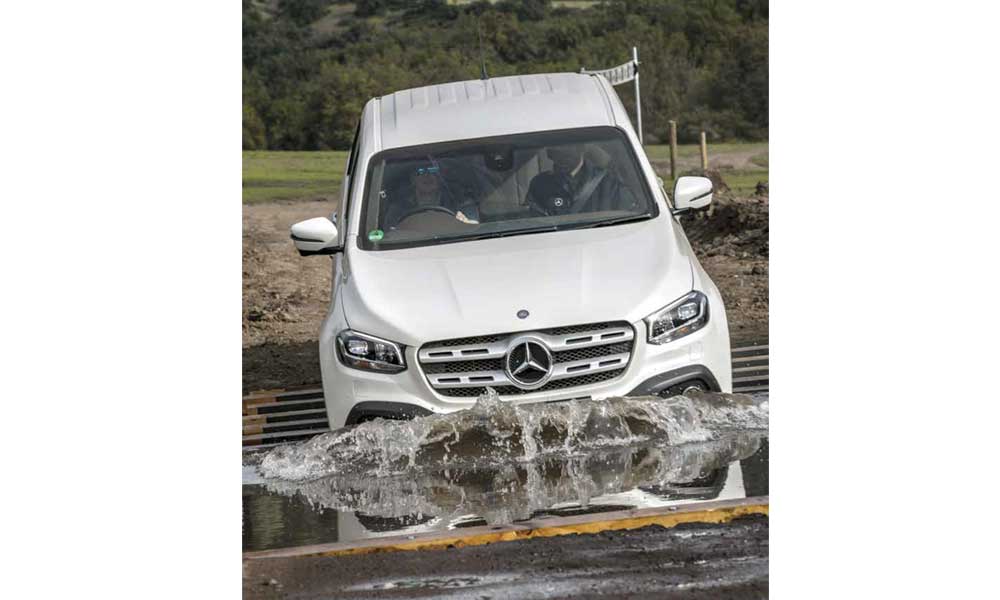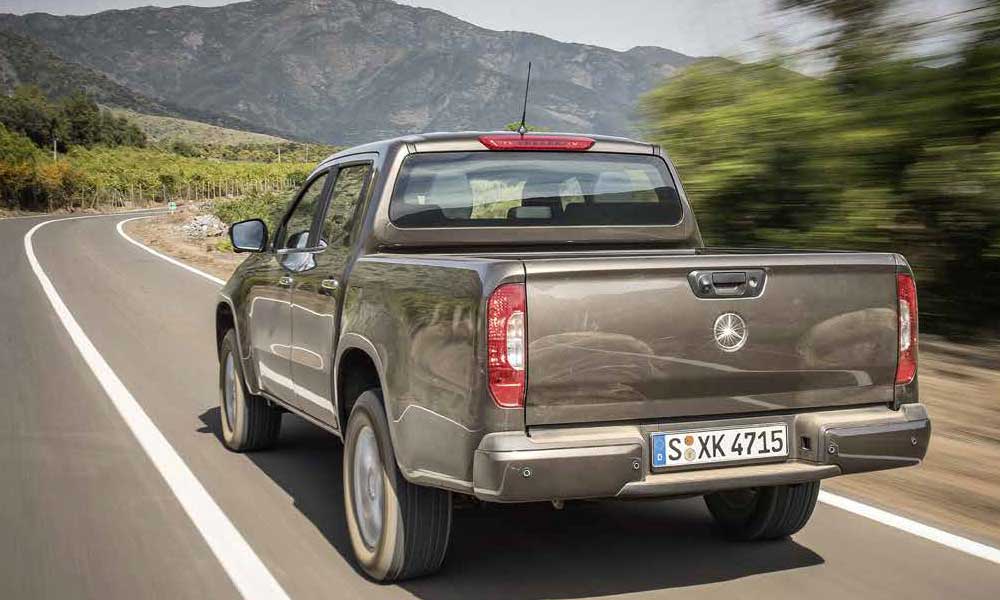After years of prelaunch hype, a song-and-dance first glimpse in Sweden and a chauffeured drive (we occupied the passenger seat) at the international reveal in Cape Town last year, we finally got to drive the much-vaunted Mercedes-Benz X-class. We travelled halfway around the world, to Chile in South America, to do it.
We’re not really the betting types, but we’d be willing to put some dosh on the fact that the Mercedes-Benz X-Class will sell very well when it arrives in South Africa early this year.
No matter the fact that is shares much of its drivetrain with the Nissan Navara (and therefore also the upcoming Renault Alaskan). No matter that it has a Nissan key with the three-pointed star belatedly replacing the Nissan badge. No matter that Karl Benz, the man who literally invented ‘the car’ would probably choke on his Schorle if he had known a vehicle with his name on it is based on a Japanese bakkie.
Average Joe probably just won’t be bothered by such details. It’s a Benz. There are three-pointed stars all over the show to state as much. And for many customers, that will be the biggest drawcard.
Before we get stuck into driving the new X-Class, some more background on how the Germans said they Mercedes-ised the Nissan Navara.
Stripped to the bone
It all started about five years ago. That’s when Nissan and Mercedes-Benz decided to embark on this joint venture (JV), following several other successful partnerships. The first phase of the project saw the Mercedes-Benz Commercial Vehicle engineers completely strip a Navara to the bone, examining every part, the structure and so on.
Some parts were retained. Others were replaced with parts designed and built according to the German manufacturer’s specifications. The ladder frame chassis was beefed up, and made more robust.
The steering shaft was upgraded to a heftier Benz-designed version. This not only increased the integral strength of the part, but also added a heavier steering feel that is apparently more in line with what Mercedes customers are used to.
Comfort is a Mercedes hallmark, so the Nissan’s much- vaunted five-link coil sprung rear suspension received plenty of attention. Some parts of the suspension were upgraded, and the dampers are different to the ones used in the Navara.
Setting a new benchmark for bakkies, the entire X-Class range features a full disc brake set-up (compared to the Navara’s disc/drum system). This is in line with the Merc bakkie’s specific ‘lifestyle pickup’ positioning, and its role as a rugged but comfortable SUV with benefits (like the ‘bak’).
In the noise, vibration and harshness (NVH) department, the Mercedes engineers also completed plenty of development work to ensure that the X-Class is at the sharpest end of the field in the refinement race.
The engine is the same 2.3-litre four-cylinder twin-turbo diesel that is used in the Nissan. It delivers exactly the same power and torque for its role in the Benz, and it is available with the Nissan’s seven-speed automatic, or six-speed manual, gearbox. More on the other engine options and upcoming 190kW V6 a bit later.
The interior is obviously new: a Benz badge added to the Navara interior, as Renault has done with the Alaskan, would not have gone down well. So there’s a new dashboard with a centre screen (on all models, but size and quality of screen differs depending on model). The instrumentation is all familiar Benz ware, as is the three-spoke, multifunction steering wheel.
The X-Class also gets Merc’s familiar multifunctional touchpad, which is located between the front seats, behind the gear lever. There’s plenty of Mercedes’ man-made leather finishing options for the seats, too. And the swooping dashboard in front of the passenger can be had with a range of finishes: from fake carbon fibre, fake wood veneer to fake brushed aluminium.
The new Benz bakkie will be available with three levels of specification: Pure, which is the entry-level offering; Progressive, representing the middle of the range; and Power, with most of the bells and whistles.
The X-Class features a new jacket on the outside, too. Although the original concept models were futuristic and daring, the production model is, as you’d expect, a bit more toned down. Nevertheless, it’s a good-looking, modern bakkie that is a whisker wider than the Navara. The look of the tail is maybe just okay, and not great. But that’s all about personal perceptions, of course.
Mercedes-Benz spent a lot of time developing accessories for the X-Class. There’s an impressive list ranging from canopies to side-steps and interior options.
That, in a nutshell, is how a Nissan Navara was transformed into a Mercedes-Benz X-Class.
Let’s take it for a drive then.

Getting jiggy with it on the road
Foot on the brake pedal, press the ‘Start’ button. The 2.3-litre four-pot diesel comes alive under the bonnet. But it doesn’t quite sound like it does in the Nissan Navara.
Mercedes’ engineers have clearly done their bit in the NVH department; the X250d’s cabin is, without any doubt, better insulated and more refined than that of the Nissan Navara.
The rest of the cabin is typical Benz, with a distinctly upmarket feel. From the buttons on the steering wheel to the instruments to the multifunctional touchpad that controls the multimedia system. The one thing we initially miss is a button to deactivate the traction control, but we find it slightly hidden from the driver’s view behind that multifunction touchpad.
The part-time ‘4MATIC’ four-wheel-drive system comes directly from the Navara, as does the twist dial on the dashboard that allows the driver to select between 2H, 4H and 4Low. More on that later, when we hit the 4×4 track.
Hook Drive, and off we go. Again, it is obvious that the engine, which is not the most refined to start with, is running much quieter in the Benz than in the Navara. Easing out of Santiago, the capital of Chile, the Benz is as solid and composed as a Mercedes GLE.
Ditto with the twisty sections… with 18-inch highway terrain tyres, the X250d handles more like a well-sorted SUV than a bakkie. The steering feedback is great, too. However, the twin-turbo diesel mill doesn’t seem particularly pleased when you start pressing on. The gearbox can be found napping at times, and slow on the downshifts.
Overall, the bakkie just doesn’t feel nippy, or particularly brisk. It seems to prefer that the 450Nm do the hard yards between 1 500 and 2 500r/min.
We tackle a badly corrugated dirt mountain pass, and select 4H. Here the Benz feels solid, but it seems to bounce from corrugation to corrugation more than we expected.
We open the windows, taking in the fresh mountain air, and there’s that Navara 2.3D clatter and slight whine, bouncing back at us from the mountainside.
The German engineers have certainly improved the X250d’s ride and handling on tar, offering car-like dynamics. But it appears to have come at the price of a less pliant ride on a badly corrugated dirt road.

Getting jiggy with it off the road
Mercedes-Benz had turned a former motocross track into a 4×4 test track for this event. Truth be told though, it was a track that could be completed in a two-wheel-drive bakkie with a rear differential lock.
Nevertheless, it allowed us the opportunity to put the Merc’s array of 4WD tricks to the test in a no-risk environment. The selection between 2H and 4H can be made up to 100km/h. For more difficult 4×4 driving there is also a transfer case (4LOW), as well as an optional rear differential lock (apparently only an option on 4Matic models).
There is a downhill speed regulation system (DSR), which is activated via a button on the dashboard. The system keeps the speed at 8km/h in 4H and 5km/h in 4LOW. Hill start assist is standard. When you stop on an incline, and want to take off again, the system will automatically ‘hold’ the bakkie for five seconds, allowing for an easy pull-away.
An optional 360-degree surround view camera system (called Parking Package) also makes navigating off-road obstacles, well… more scenic.
In real-world 4×4 conditions, systems like these rarely play a decisive role. But it certainly is cool, and comprehensive. The system is much handier for those tight parking spots.
Some numbers: the claimed ground clearance is 202mm (a realistic figure, and not an overestimated one as is often the case with other manufacturers), the forging depth is 600mm, approach angle is 29 degrees and the departure angle 24 degrees.
So, how does the X250d 4Matic fare in the 4×4 depart-ment? Well, it completed all the tasks as advertised, on the easy track. We can’t wait to head to grade five 4×4 challenge though… that’s when we’ll really find out how good it is. Or not.

In a nutshell then…
There is no doubt that Mercedes-Benz has taken the Nissan Navara base to a new level of refinement and class. It looks good. It drives well. It’s solid, safe and luxurious. It’s certainly aspirational.
What it maybe is not is the huge leap upwards from the Navara as we thought it would be.
Much will depend on pricing when the X-Class lands here in the beginning of 2018. There seems to be good news though: according to Mercedes-Benz, the company is planning for volume sales in South Africa, and not just niche sales. So, reading between the marketing lines, the Benz X-Class should be competitively priced.
A keen asking price, and that three-pointed star on the nose… it will inevitably be a sales hit.
Here’s looking forward to next year, and the arrival of a vehicle that may very well cause a ruckus in the hotly contested bakkie segment in South Africa.
Mercedes-Benz X250d 4MATIC AT
Engine Four-cylinder, twin-turbo diesel
Displacement 2 298cc
Power 140kW @ 3 750r/min
Torque 450Nm @ 1 500–2 500r/min
Transmission Seven-speed automatic
4WD system Part-time (2H, 4H and 4Low), rear differential lock (optional)
Electronic driving aids Traction control, electronic
Suspension front Double wishbone, coil springs, stabiliser bar
Suspension rear Multi link, coil springs, stabiliser bar
Brakes Internally ventilated discs, front and back
Ground clearance (claimed) 202mm
Forging depth 600mm
Tyres 255/60 R18
270kW? In a bakkie?
Volkswagen waited seven years after the launch of the original Amarok two-litre range before it finally unleashed the Amarok 3.0TDI V6. Now it can hardly keep up with demand for the V6.
Mercedes has clearly seen the writing on the wall: its V6 diesel derivative is now in the final stages of development, and it will officially be launched mid-2018. It is powered by Merc’s well-known three-litre V6 turbodiesel that delivers 190kW and 620Nm of torque, the latter peaking at a low 1 600r/min.
Like the Amarok V6, the X350d 4MATIC features a permanent four-wheel-drive system, coupled to Merc’s 7G-TRONIC PLUS automatic gearbox. The Merc has a transfer gearbox, too, and low range can be selected while the Benz is on the move.
The X-Class will initially be available in South Africa in X250d and X220d derivatives only. So that’s the 140kW/450Nm twin-turbo engine, and a 120kW/403Nm version of the same engine.
The X200 will be available in some overseas markets. It is powered by a two-litre turbopetrol engine (122kW). And then there will be the range-topping X350d V6 with that 190kW engine, but this will only arrive in SA later in 2018.
Although the Benz engineers would not quite admit it, there is the possibility that Merc’s 3.0 V6 turbopetrol engine (with 270kW and 520Nm) may eventually be crowned the halo model of the range.
Imagine that: the X43 AMG. Sounds like a grand plan to us. www.leisurewheels.co.za

